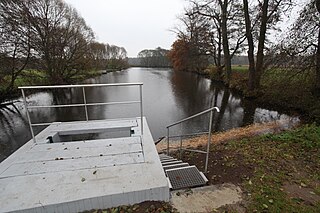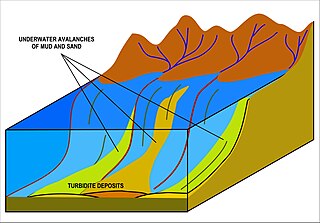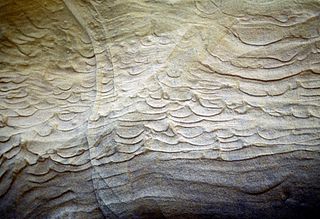
Settling is the process by which particulates settle to the bottom of a liquid and form a sediment. Particles that experience a force, either due to gravity or due to centrifugal motion will tend to move in a uniform manner in the direction exerted by that force. For gravity settling, this means that the particles will tend to fall to the bottom of the vessel, forming a slurry at the vessel base.
The Richardson number (Ri) is named after Lewis Fry Richardson (1881–1953). It is the dimensionless number that expresses the ratio of the buoyancy term to the flow shear term:
In fluid dynamics, the Boussinesq approximation is used in the field of buoyancy-driven flow. It ignores density differences except where they appear in terms multiplied by g, the acceleration due to gravity. The essence of the Boussinesq approximation is that the difference in inertia is negligible but gravity is sufficiently strong to make the specific weight appreciably different between the two fluids. Sound waves are impossible/neglected when the Boussinesq approximation is used since sound waves move via density variations.
In fluid dynamics, a gravity current or density current is a primarily horizontal flow in a gravitational field that is driven by a density difference in a fluid or fluids and is constrained to flow horizontally by, for instance, a ceiling. Typically, the density difference is small enough for the Boussinesq approximation to be valid. Gravity currents can be thought of as either finite in volume, such as the pyroclastic flow from a volcano eruption, or continuously supplied from a source, such as warm air leaving the open doorway of a house in winter. Other examples include dust storms, turbidity currents, avalanches, discharge from wastewater or industrial processes into rivers, or river discharge into the ocean.

A turbidite is the geologic deposit of a turbidity current, which is a type of amalgamation of fluidal and sediment gravity flow responsible for distributing vast amounts of clastic sediment into the deep ocean.

A turbidity current is most typically an underwater current of usually rapidly moving, sediment-laden water moving down a slope; although current research (2018) indicates that water-saturated sediment may be the primary actor in the process. Turbidity currents can also occur in other fluids besides water.

Joseph Valentin Boussinesq was a French mathematician and physicist who made significant contributions to the theory of hydrodynamics, vibration, light, and heat.

The Bouma Sequence describes a classic set of sedimentary structures in turbidite beds deposited by turbidity currents at the bottoms of lakes, oceans and rivers.

In geology, saltation is a specific type of particle transport by fluids such as wind or water. It occurs when loose materials are removed from a bed and carried by the fluid, before being transported back to the surface. Examples include pebble transport by rivers, sand drift over desert surfaces, soil blowing over fields, and snow drift over smooth surfaces such as those in the Arctic or Canadian Prairies.
The Bagnold number (Ba) is the ratio of grain collision stresses to viscous fluid stresses in a granular flow with interstitial Newtonian fluid, first identified by Ralph Alger Bagnold.
Boussinesq approximation may refer to several modelling concepts – as introduced by Joseph Valentin Boussinesq (1842–1929), a French mathematician and physicist known for advances in fluid dynamics:

Natural convection is a type of flow, of motion of a liquid such as water or a gas such as air, in which the fluid motion is not generated by any external source but by some parts of the fluid been heavier than other parts. In most cases this leads to natural circulation, the ability of a fluid in a system to circulate continuously, with gravity and possible changes in heat energy. The driving force for natural convection is gravity. For example if there is a layer of cold dense air on top of hotter less dense air, gravity pulls more strongly on the denser layer on top, so it falls while the hotter less dense air rises to take its place. This creates circulating flow: convection. As it relies on gravity, there is no convection in free-fall (inertial) environments, such as that of the orbiting International Space Station. Natural convection can occur when there are hot and cold regions of either air or water, because both water and air become less dense as they are heated. But, for example, in the world's oceans it also occurs due to salt water being heavier than fresh water, so a layer of salt water on top of a layer of fresher water will also cause convection.
Particle-laden flows refers to a class of two-phase fluid flow, in which one of the phases is continuously connected and the other phase is made up of small, immiscible, and typically dilute particles. Fine aerosol particles in air is an example of a particle-laden flow; the aerosols are the dispersed phase, and the air is the carrier phase.
Bagnold's fluid refers to a suspension of neutrally buoyant particles in a Newtonian fluid such as water or air. The term is named after Ralph Alger Bagnold, who placed such a suspension in an annular coaxial cylindrical rheometer in order to investigate the effects of grain interaction in the suspension.

A sediment gravity flow is one of several types of sediment transport mechanisms, of which most geologists recognize four principal processes. These flows are differentiated by their dominant sediment support mechanisms, which can be difficult to distinguish as flows can be in transition from one type to the next as they evolve downslope.

The Lowe sequence describes a set of sedimentary structures in turbidite sandstone beds that are deposited by high-density turbidity currents. It is intended to complement, not replace, the better known Bouma sequence, which applies primarily to turbidites deposited by low-density turbidity currents.

A grain flow is a type of sediment-gravity flow in which the fluid can be either air or water, acts only as a lubricant, and grains within the flow remain in suspension due to grain-to-grain collisions that generate a dispersive pressure to prevent further settling. Grain flows are very common in aeolian settings as grain avalanches on the slip faces of sand dunes. By contrast, pure grain flows are rare in subaqueous settings, where the grains in a flow are generally held in suspension dominantly by traction, saltation, fluid turbulence and/or grain buoyancy when the grains are floating in the clay matrix of a mud flow. However, grain-to-grain collisions are very important as a contributing process of sediment support in subaqueous, sand-rich, high-density turbidity currents. The high concentrations of sand that develop at the base of high-density flows brings grains close enough together that frequent grain-to grain collisions are inevitable and result in layers of sediment that are inverse graded as the smaller grains are able to fall in between larger grains and settle out beneath them.

Liquefied flows are types of sediment-gravity flows in which grains within the flow are kept in suspension by the upward movement of fluid. They form in granular substances where the concentration of suspended mud is too low to develop cohesive forces within the flow. As grains at the base of the suspension settle out, fluid that is displaced upward by the settling generates pore fluid pressures that can help suspend grains in the upper part of the flow. Application of an external pressure to the suspension will initiate flow. This external pressure can be applied by a seismic shock, which may turn transform loose sand into a highly viscous suspension as in quicksand. Generally as soon as the flow begins to move, fluid turbulence results and the flow rapidly evolves into a turbidity current. Flows and suspensions are said to be liquefied when the grains settle downward through the fluid and displace the fluid upwards. By contrast, flows and suspensions are said to fluidized when the fluid moves upward through the grains, thereby temporarily suspending them. Most flows are liquefied, and many references to fluidized sediment gravity flows are in fact incorrect and actually refer to liquified flows. Because fluid is displaced upward in these types of flows, dewatering features such as dish structures, pillars, pipes and dikes are common.
The term gravity current intrusion denotes the fluid mechanics phenomenon within which a fluid intrudes with a predominantly horizontal motion into a separate stratified fluid, typically along a plane of neutral buoyancy. This behaviour distinguishes the difference between gravity current intrusions and gravity currents, as intrusions are not restrained by a well-defined boundary surface. As with gravity currents, intrusion flow is driven within a gravity field by density differences typically small enough to allow for the Boussinesq approximation.

A powder is a dry, bulk solid composed of many very fine particles that may flow freely when shaken or tilted. Powders are a special sub-class of granular materials, although the terms powder and granular are sometimes used to distinguish separate classes of material. In particular, powders refer to those granular materials that have the finer grain sizes, and that therefore have a greater tendency to form clumps when flowing. Granulars refers to the coarser granular materials that do not tend to form clumps except when wet.











